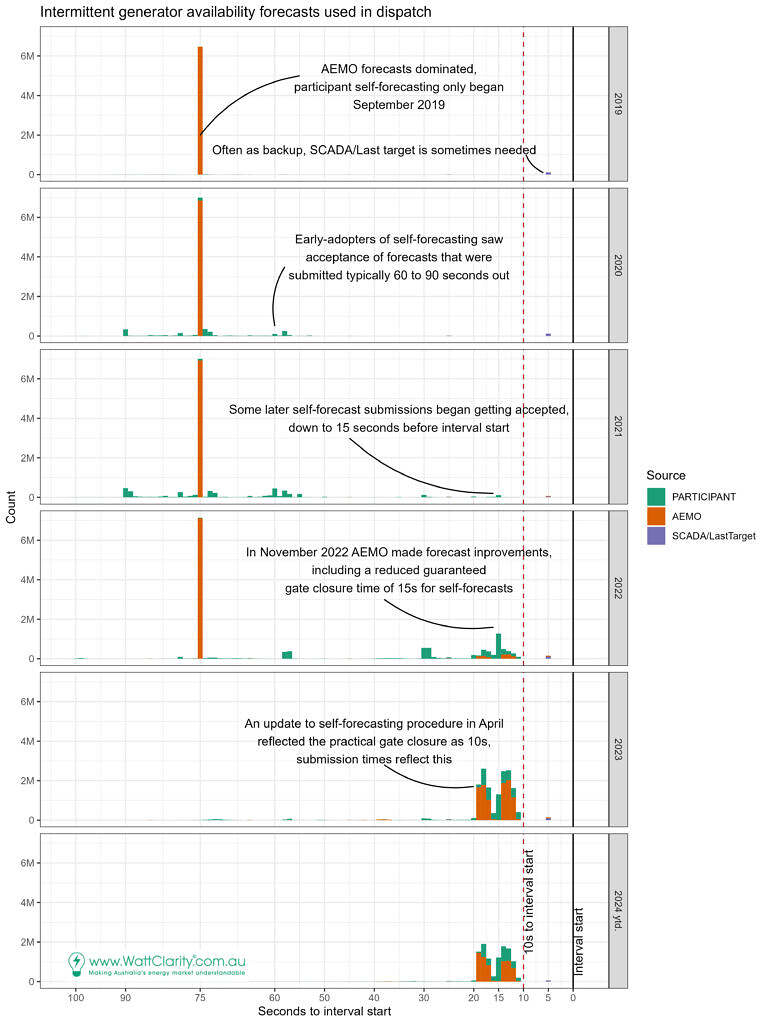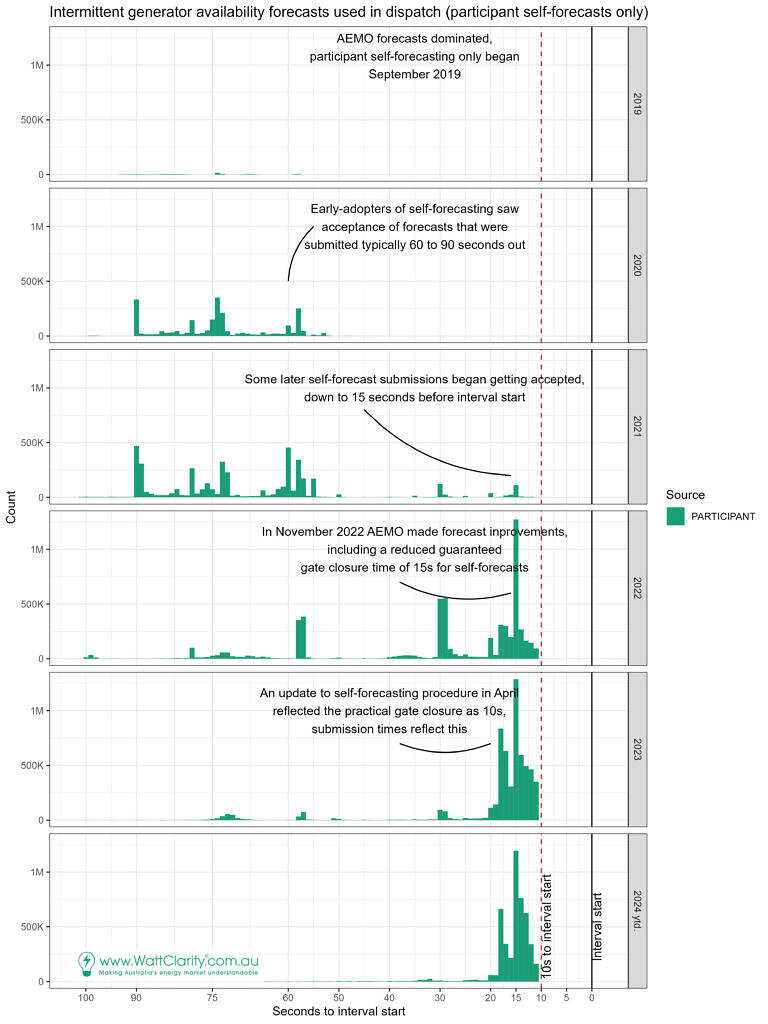Looking back at Gate Closure #3 from 2024
In this article we uncover how Gate Closure #3 – the cut-off for dispatch UIGFs – has changed over time.
As noted on this Glossary Page, there are several different types of ‘Gate Closure’ applicable to operations in Australia’s National Electricity Market (NEM).
Other types of gate closure
Paul analysed Gate Closure #2 in A long-range trend of changing times for ‘Gate Closure #2’; the cut-off for energy and FCAS market rebids, where volumes within price bands can be changed.
Gate Closure #1 is the cut-off for daily market bids. These bids fix the price bands that will apply for the next trading day’s bids.
Gate Closure #3 is the cut-off for UIGF submissions
UIGFs are the unconstrained intermittent generation forecasts of semi-scheduled wind and solar units.
A UIGF represents the estimate of maximum power in MW that a unit could deliver at the end of the dispatch interval, if unconstrained by network congestion or system security constraints. In other words, the physical availability of the unit.
Here, we are talking about the UIGF used for dispatch. A forecast needs to be submitted before the start of the dispatch interval so NEMDE can apply it in its calculations.
Given this, how long before the start of the interval is it needed?
And to find the answer, we represent gate closure as seconds to the start of a UIGF’s relevant interval.
Forecast submission time as seconds to interval-start
We prepared the following chart to summarise the submission time of each individual UIGF that was used in dispatch.
We are distinguishing between:
- AEMO forecasts which originate from AWEFS for wind, ASEFS for solar, or the simpler ‘FCST’ used when those two, more sophisticated, forecasting models are not available for use.
- PARTICIPANT forecasts, representing participant self-forecasts.
- SCADA / Last target forecasts which represent backup options if the above sources are not available.
The chart is zoomed-in to 100 seconds to interval-start because this is the predominant period from which the forecasts used in dispatch are submitted.

The timing of UIGFs used in dispatch has reduced from 75 seconds to 10 seconds.
Observations
2019
AEMO submitted its forecasts at 75s to interval-start. There were very few participant self-forecasts.
- Participant self-forecasting began in September 2019.
- Forecasts submitted at 5s to interval-start are used, these are typically of SCADA (output power) or last target origin.
2020
The use of Participant self-forecasting was emerging.
- AEMO forecasts remain at 75 seconds to interval-start.
- We observe participant forecasts submitted around 60s to interval-start as a cluster.
2021
We can see participant self-forecasts submitted later than 60s.
- At times, down to 15s before interval start.
2022
These forecast submission times were still meeting gate closure.
- An update to the self-forecasting assessment procedure in January included a reduction in the nominal gate closure time from 70s to 15s.
- In November 2022 AEMO made forecast upgrades, and this included pushing out its submission times from 75s to under 20s.
2023
Systems submitted forecasts between 20s and 10s before interval-start, for use in dispatch. An April update to the self-forecasting procedure included a reduced gate closure time of 10s to interval-start (down from 15s). This is documented so that participants can have confidence forecasts meeting that submission threshold will be accepted for use in dispatch.
- While a bar representing forecasts submitted at 10s is not easily visible, it is there – just small (click the image for higher-resolution).
2024
Dispatch uses forecasts that have been typically offered between 20s and 10s to interval-start.
- There are some that were used and submitted later, between 20s and 40s. These are evident by very small bars in the 2024 chart.
- Two distinct groups emerged in 2023 and persist into 2024:
- Forecasts submitted around 19 – 17 seconds before interval-start, and
- Forecasts submitted 15 – 12 seconds before interval-start.
Conclusions
Gate closure #3 represents the cut-off time for dispatch UIGFs. This is 10 seconds, in 2024. It has been that way (although not always officially) since 2021.
Dispatch uses forecasts submitted at 5s to interval-start occasionally. These represent backup forecasts selected from mechanisms secondary to AWEFS, ASEFS and the participant self-forecast.
Two distinct groups exist in submission times covering most forecasts in 2023 and 2024, but these groups are both within 20s to interval-start.
PS1 Inspecting just the participant self-forecasts
Participants find the gate closure time of relevance if they submit UIGF self-forecasts for dispatch. Missing the cut-off means the forecast is not used in dispatch. Often, multiple submissions for a single interval will be made to ensure the most recent recent forecast is accepted. Typically, the latest one within the gate closure cut-off is used.
For this reason, here is chart as above, filtered to participant forecasts:

The timing of UIGFs from participant self-forecasts, used in dispatch, has reduced from 90+ seconds to 10 seconds.


Thanks Linton for this article. Importantly, the reduction in gate closure has allowed improved forecasts to be used by NEMDE. AEMO’s own figures quote an 11-14% improvement in MAE to their ASEFS/AWEFS forecasts and I know a significant part of this improvement is due to being able to use later site measurements as inputs to the forecast.
At ETSI we see an even greater improvement when moving from a 60-second to 10-second gate closure. The result of these accuracy improvements is downward pressure on regulation FCAS utilisation, evidenced by AEMO not having increased regulation procurement volumes despite the large increase in VRE capacity (admittedly PFR has helped frequency control around the PFR Control Band).